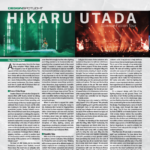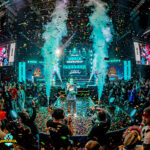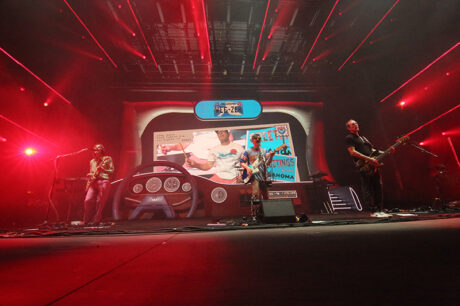
Weezer’s 2023 Summer tour Indie Rock Road Trip brought their fans along as passengers with the band performing on the dashboard of the car, courtesy of an imaginative production design by Blank Wall Creative’s Travis Shirley. Working with Weezer for the first time, Shirley connected quickly with lead singer Rivers Cuomo. They landed on the idea of going on a road trip of America as the core concept for the tour journey. Shirley explains the process to PLSN.
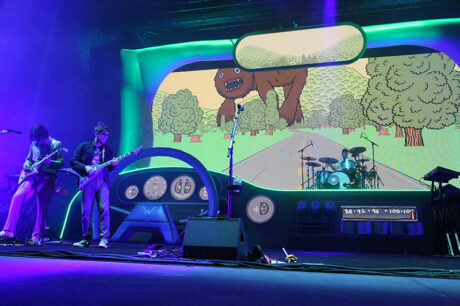
TRAVIS SHIRLEY
Production Designer / Lighting Designer
How did the design for this Weezer tour come about?
This being my first tour working with Weezer was an amazing collaboration right from the start. When their management team reached out to me, they immediately connected me with Rivers, who is extremely intuitive, and extremely intelligent. The band wanted to tour America and remind their fans why we all love Weezer so much. They’ve done tours in the past couple of years; some co-headlining and some as mega support on other tours, but they hadn’t done a hard ticket date of their own in a while. With this tour they really wanted to give the fans a full on Weezer show. Rivers had some ideas for the name of the tour and between different variations we ended up with the Indie Rock Road Trip. We understood the stage scenography and the concept of the tour could just take on a meaning of its own with the name being Indie Rock Road Trip. With the tour name in place, we created a very detailed, probably one of the more detailed, storyboard concepts that I’ve ever done for a tour.
We wanted to take the fans along on this journey throughout America of this indie rock band. So, we created this stage set that essentially evoked the sense that you were along for the ride in a car with the band. They were there performing on, and around, the dashboard of a car and you were looking through a windshield, which was actually a video screen. I think the stage scenography from the first moment you see it literally puts the audience in the passenger seat with Weezer. The production, the video content design, and the direction took the audience with them full on.
Our concept of what the show is, when we start, you hear the engine turn on, you see the radio dials move, and we’re in the car with Weezer leaving LA, driving through Beverly Hills, which is one of their famous songs. Then we travel through to the beaches of Santa Monica, we go through the Sequoia National Forest, we even go to Mount Weezermore. Different kinds of Weezer-inspired elements are continuously popping up, from Mount Weezermore to the Hollywood sign that spells out Weezer, to different Weezer restaurants and we eventually end up in the city that we’re currently playing in! The last song is a giant postcard emoji that says Greetings from i.e.: Houston, Texas or Greetings from Des Moines, Iowa and it’s addressed back to Weezer in LA where we started the whole journey. It’s literally this full-circle storyline of Weezer going on this tour ending the show with essentially everyone writing Weezer a big postcard. It’s a really cool captivating show.
The dashboard and the windshield really work, it looks great. Who built the various elements for you?
Gallagher Staging out of Nashville built the dashboard for us, Sean at Inflatable Design Group built the windshield, the rear view mirror, and the steering wheel. Screenworks provided all the video screens, and Christie Lites did all of the lighting trusses. It was a very collaborative and synergistic effort of everyone’s expertises. From the moment you see the stage, after curtain from the support acts drops, you know that you’re with Weezer in a car going on a trip. I really couldn’t have been happier with the way that the scenic bill came together.
Tell us a bit about the lighting design.
The lighting design was very aggressive, it’s by no means a small lighting show, but it was meant to really accompany and frame out the stage scenography. I wasn’t looking to necessarily make lighting trusses visible or part of the production, whereas on some shows I do. On this one, I really wanted the scenic to be the focal point. A lot of the lighting rig was meant to texturize some of the scenic elements, whether it be the inflatables or the dashboard. It was a much more theatrical approach than I think a lot of tours that are, touring, especially in the rock and roll shed markets. More than lighting the stage scenography, it’s still a rock show at the end of the day so the lighting was a huge part of it. I’m not usually a huge fan of video being so narrative, but it needed to be in this case and as a result it worked out perfectly. It did put a little bit more pressure on the lighting design, the cue structure, and programming to bring the musicality of it to life a bit more. I think that’s where the lighting and the programming really shined. The Co-Lighting Designer and Programmer Drew Nagy, really did a wonderful job of cueing the show out. I really enjoy working with Drew, he is so accomplished and great to work with. He definitely deserves the title of co-lighting designer as well as programmer. Also, I want to mention Patrick Wala, the Video Programmer. He was a lifesaver and also a joy to work with. I think he’s got a long future ahead of him, a real bright rising star in video.
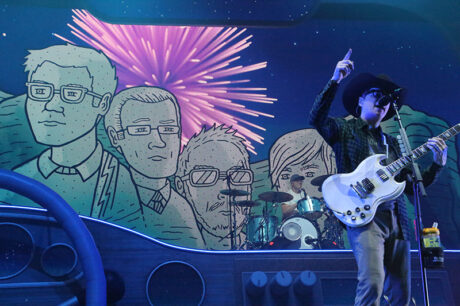
Talk about the challenge of creating so many looks over the course of the performance.
The set list was literally, pun intended, the roadmap of the show. Between myself and our content team, SRND [pronounced Surround] Studios, we had to find how to keep the narrative alive without becoming boring. We didn’t always want to be in the driver’s seat driving through the countryside. We knew that we had to create some stops along the way, pit stops, if you will. SRND were a huge part of the process for me, collaborating and building the content to help create the roadmap and the story. At one point we stopped at a drive-in movie theater and that’s where Weezer performed on the big screen of the drive-in theater, a little bit more of an acoustic version of some of their songs. Another moment we go to a dance club, and you see Buddy Holly dancing around. It was more of like, ‘how do we keep the narrative strong and alive without forcing it for too long?’ Again, pun intended, those pit stops along the way were really a huge part of the show and obviously a very intentional way of keeping the format of the concept alive. The band always backed up the road trip vibe, which was very important.
What were some of your key equipment choices for lighting?
It needed to be rock and roll; Christie Lites understood that. We chose some fixtures that I knew would pack a punch. It’s a large rig of [Martin] MAC Axioms, which do a great job of giving the punch that we need along with a plethora of animation lights. There were Robe BMFL WashBeams that allowed us to texturize the set the way that we needed. At the band’s request, they don’t do followspots. That meant we had to get clever about how we did some side lighting and front lighting to make sure that the band is seen and visible, but not necessarily make them stand out. It’s not about an individual performer, it’s about the band, all four members. We had to really balance the lighting so that the entire band was seen, but in the big picture of everything: the band, the stage, and the video screen all blended into one. The particular equipment choices weren’t necessarily super important for me on this one as much as it was more the level and the integration of how we used the lights. And again, I go back to how Drew programmed it to keep the momentum alive when the narration was busy doing what it needed to do. Lighting was definitely on overdrive on this, but done in a very tasteful way.
What’s something you think people might be surprised about the design?
I think people might be surprised about the amount of production on this tour, since it is an indie rock band. Most indie rock bands don’t tour with massive amounts of production. Also, I think they might be surprised by how the concept of the show is such a visible through line of the show, and that is due to the way the content, the stage scenography, and everything is so integrated. I’ve had quite a few people in the industry say to me that they were really surprised that Weezer did such a theatrical, thematic show. I think the The band took a giant step by doing that, they wanted to do something that was more themed. I credit Rivers and the band for wanting to take that jump with me into something more thematic. So, I think that’s what most people in our industry would walk away with, not just thinking the design is cool, the lighting’s cool, and that the stage set is cool, but that the overall concept of the show; how visible and creative it is, that that is cool.
Anything else about working with Weezer you’d like to mention?
The production team: Tom Addison, the Production Manager, Tom [O’Keefe], the Tour Manager. They were both wonderful to collaborate and work with. As I’ve said, Weezer traditionally hasn’t had such an intense show, but they were very accommodating, understanding, and welcoming to my team. They made sure we got everything we needed to create and produce this show. Honestly, the whole Weezer crew, a lot of them have been there for years, and they were all a joy to be around. It had a family-like quality that really lent itself to the whole road trip mentality. It’s a giant family going on tour, AKA on an Indie Rock Road Trip together.
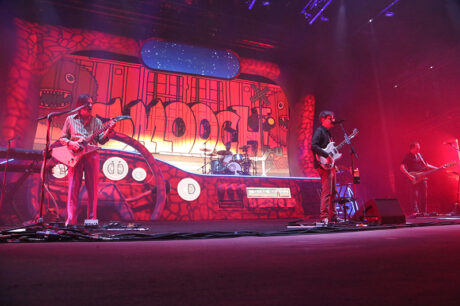
PRODUCTION TEAM
- Tour Manager: Thomas O’Keefe
- Production Manager: Tom Addison
- Production Designer/Lighting Designer: Blank Wall Creative/Travis Shirley
- Co-Lighting Designer/Programmer: Drew Gnagey
- Video Programming/On-Site Content Design: Patrick Wala
- Lighting Crew Chief: Charles Teer
- Technical Director: Evan Rodecap, The Rodecap Company
- Creative Producers: Blank Wall Creative/Vanessa Johnson, Dani Edgren
VENDORS
- Lighting: Christie Lites, Robert Roth
- Video: Screenworks NEP, Nick O’Bryen
- Content: SRND Studios
- Technical Design and Project Management: The Rodecap Company
- Scenery: Inflatable Design Group
GEAR
Lighting
- 66 Martin MAC Axiom Hybrid
- 44 Robe BMFL WashBeam
- 104 GLP impression X4 Bar 20
- 32 GLP JDC1 Strobe
- 6 Reel EFX DF‐50 Diffusion Hazer
- 2 MDG ATMe Haze Generator
- 5 Martin JEM ZR45 Fog Machine
- 14 Fans
- 2 grandMA3 full-size
- 1 grandMA3 light
- 4 grandMA NPU
Video
- 110 ROE Visual Carbon CB5 LED Panel (1200×600)
- 47 ROE Visual Carbon CB5 LED Panel (600×600)
- 4 Brompton Technology Tessera SX40 LED Processor
- 6 Brompton Technology Tessera XD Data Distribution
- 2 Resolume DVS G1 Media Server
- 1 Ross Video Carbonite Black Panel 3ME Switcher
- 1 Ross Video Carbonite Ultra Switcher Frame
- 1 Ross Video Ultrix Router
- 1 Screenworks Monitor and CCU/ENG Control Package
- 2 Blackmagic Design HyperDeck Studio 4K
- 4 Sony FB80 Camera
- 4 Canon Lenses
- 1 Panasonic AW-UE150 4K PTZ Camera
- 1 Panasonic AW-RP120 PTZ Controller
